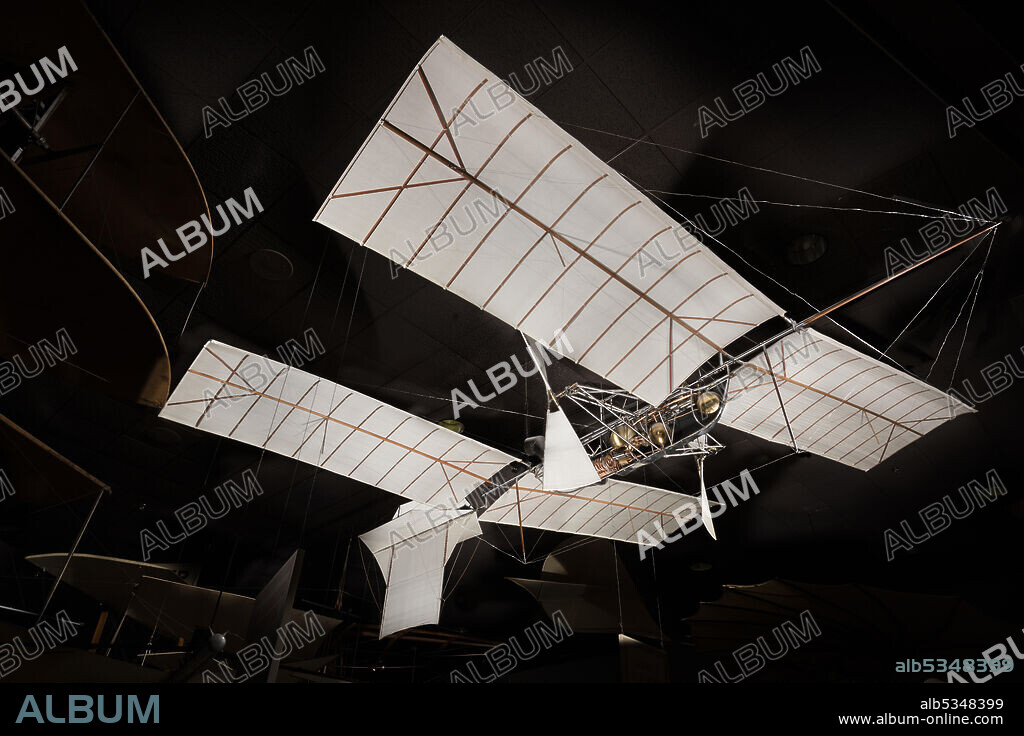alb5348399
SMITHSONIAN INSTITUTION. Langley Aerodrome Number 5,1896. Creator: Smithsonian Institution.

|
Add to another lightbox |
|
Add to another lightbox |



Buy this image.
Select the use:

Author:
Title:
Langley Aerodrome Number 5,1896. Creator: Smithsonian Institution.
Caption:
Model of the unpiloted, tandem-wing experimental aircraft built and tested by Samuel P. Langley. One one-horsepower, one-cylinder steam engine turning two pusher propellers via geared transmission system. Silk covering. Natural fabric finish; no sealant or paint of any kind. Samuel Pierpont Langley became the third Secretary of the Smithsonian Institution in 1887. In 1891, he began experiments with large, tandem-winged models powered by small steam and gasoline engines he called aerodromes. After several failures with designs that were too fragile and under-powered to sustain themselves, Langley had his first genuine success on May 6, 1896, with his Aerodrome Number 5. It made the world's first successful flight of an unpiloted, engine-driven, heavier-than-air craft of substantial size. It was launched from a spring-actuated catapult mounted on top of a houseboat on the Potomac River near Quantico, Virginia. Two flights were made on May 6, one of 1,005 m (3,300 ft) and a second of 700 m (2,300 ft), at a speed of approximately 40 kph (25 mph). On both occasions, the Aerodrome Number 5 landed in the water, as planned, because, in order to save weight, it was not equipped with landing gear.
Personalities:
Credit:
Album / Heritage Art/Heritage Images
Releases:
Image size:
8688 x 5792 px | 144.0 MB
Print size:
73.6 x 49.0 cm | 29.0 x 19.3 in (300 dpi)
Keywords:
19 CENTURY • 19TH CENTURY • 19TH CENTURY. • 19TH • 19TH-CENTURY • AEROPLANE • AIR AND SPACE MUSEUM • AIR TRANSPORT • AIRCRAFT • AIRPLANE • AMERICA • AMERICAN • AVIATION • CENTURY • COLOR • COLOUR • COPPER ALLOYS • CORD • COUNTRY • CRAFT-AIRCRAFT • EDUCATION • EDUCATIONAL INSTITUTION • FLIGHT • FLUSH • LANGLEY • LOCATION • MODEL • NASM • NATIONAL AIR AND SPACE MUSEUM • NINETEENTH CENTURY • OBJECT • OBJECTS • POWERED FLIGHT • S P • SAMUEL LANGLEY • SAMUEL P LANGLEY • SAMUEL P • SAMUEL P. LANGLEY • SAMUEL PIERPONT LANGLEY • SAMUEL PIERPONT • SAMUEL • SCIENTIFIC INSTITUTION • SILK • SMITHSONIAN INSTITUTION • SP LANGLEY • SP • STEEL TUBING • STEEL WIRES • TECHNOLOGY • TEXTILES: SILK • TRANSPORT • TRANSPORTATION • UMBRELLA • UNITED STATES OF AMERICA • UNITED STATES • USA • WOOD • XIX CENTURY
 Pinterest
Pinterest Twitter
Twitter Facebook
Facebook Copy link
Copy link Email
Email
